Characterization and Analysis of the Mortars of the Church of Santo Domingo in Quito (Ecuador)
Abstract
:1. Introduction
Constructive Historical Chronology of the Temple
2. Materials and Methods
2.1. Materials
2.2. Methods
3. Results
4. Discussion
5. Conclusions
Author Contributions
Funding
Data Availability Statement
Acknowledgments
Conflicts of Interest
References
- Patrimonio, I.M. de Diagnóstico del Centro Histórico de Quito. Available online: http://www7.quito.gob.ec/mdmq_ordenanzas/ComisionesdelConcejo/UsodeSuelo/CentroHistórico/InformaciónIMP/PlanParcialCentroHistórico/1.DiagnósticodelCHQ.pdf (accessed on 1 March 2021).
- UNESCO. City of Quito. Available online: https://whc.unesco.org/en/list/2/ (accessed on 8 May 2021).
- Fustillos, A. Encuentro Científico Internacional sobre Ciudades Históricas Iberoamericanas. In Proceedings of the San Francisco de Quito; Mancha, I.-U.C., Ed.; Servicio de Publicaciones de la Universidad de Castilla-La Mancha: Ciudad Real, Spain, 2005; pp. 246–273. [Google Scholar]
- Ortiz Crespo, A. Arquitectura monumental del Centro Histórico de Quito. In Centro Histórico de Quito: Problemática y Perspectivas, Serie Quito.; Dirección de Planificación, I. Municipio de Quito, Ecuador, Consejería de Obras Publicas y Transporte, Junta de Andalucía: Ministerio de Asuntos Exteriores de España, Eds.; TRAMA: Quito, Ecuador, 1990; pp. 141–164. [Google Scholar]
- Donoso Samaniego, D. Diccionario Arquitectónico de Quito; Quito Museos del banco Cent. del Ecuador: Ciudad Real, Spain, 1983; 277p. [Google Scholar]
- Descamps, F. La Loma Grande y la Plaza de Santo Domingo; Ecua-Bel, P., Ed.; Ediciones Libri Mundi: Quito, Ecuador, 1994; ISBN 978-9978-570-09-8. [Google Scholar]
- Alemán, M.; Van Balen, K. Puesta en valor del Patrimonio Arquitectonico en el Convento de Santo Domingo; Ecua-Bel, P., Ed.; Ediciones Libri Mundi: Quito, Ecuador, 1994; Volume 5, ISBN 9978-57-013-6. [Google Scholar]
- Terán Najas, R. Arte, Espacio y Religiosidad en el Convento de Santo Domingo; Ecua-Bel, P., Ed.; Ediciones Libri Mundi: Quito, Ecuador, 1994; Volume 4, ISBN 9978-57-012-8. [Google Scholar]
- Valdivieso Eguiguren, G. Convento Máximo Santo Domingo de Quito Patrimonio Cultural Dominicano: Documentos Para la Historia; Imprenta Mariscal: Quito, Ecuador, 2005; ISBN 9978-44-671-0. [Google Scholar]
- Webster, S.V. Art, Identity, and the Construction of the Church of Santo Domingo in Quito. Hisp. Res. J. 2009, 10, 417–438. [Google Scholar] [CrossRef]
- Vargas José María, O.P. El arte Ecuatoriano; Fondo de Cultura Económica: Madrid, Spain, 1945; pp. 25–150. [Google Scholar]
- Del Pino Martínez, I.; Yepes, H. Apuntes para una historia sísmica de Quito. In Centro Histórico de Quito: Problemática y Perspectivas, Serie Quito; TRAMA: Quito, Ecuador, 1990; pp. 67–100. [Google Scholar]
- Lara, M.L.; Gallegos, M.; Galarza-Gallardo, G. Study of the seismic risk of the heritage buildings of the Historic Center of Quito. In Proceedings of the TECHNOHERITAGE 2019, Science and Technology for the Conservation of Cultural Heritage, Seville, Spain, 26–30 March 2019. [Google Scholar]
- Beltrán, J.; De Vuyst, P.; Rosero, M. Conservación del Patrimonio Artístico del Convento de Santo Domingo; Ecua-Bel, P., Ed.; Ediciones Libri Mundi: Quito, Ecuador, 1994; Volume 6, ISBN 9978-57-014-4. [Google Scholar]
- Moreno, P. Informe del Estado de Conservación y Análisis de Laboratorio de la Pintura Mural del Crucero, Iglesia de Santo Domingo; Encontrada Durante los Procesos de Intervención de la Iglesia: Quito, Ecuador, 2006. [Google Scholar]
- Moropoulou, A.; Polikreti, K.; Ruf, V.; Deodatis, G. San Francisco Monastery, Quito, Equador: Characterisation of building materials, damage assessment and conservation considerations. J. Cult. Herit. 2003, 4, 101–108. [Google Scholar] [CrossRef]
- Lara, M.L.; Sanz-Arauz, D.; López-Andrés, S.; Pino, I. del Characterization and Analysis of the Mortars in the Church of the Company of Jesus—Quito (Ecuador). Minerals 2021, 11, 781. [Google Scholar] [CrossRef]
- Comité Técnico AEN/CTN 41; UNE-EN 16085: Conservación del Patrimonio Cultural. Metodología Para la Toma de Muestras de Materiales del Patrimonio Cultural. Reglas Generals. AENOR: Madrid, Spain, 2014; 10p.
- Veiga, M.R.; Aguiar, J.; Silva, A.S.; Carvalho, F. Methodologies for characterisation and repair of mortars of ancient buildings. In Proceedings of the 3rd International Seminar Historical Constructions, Universidade do Minho, Guimarães, Portugal; 2001; pp. 353–362. [Google Scholar]
- Válek, J.; Hughes, J.J.; Bartos, P. Compatibility of historic and modern lime mortars. In Proceedings of the 12th International Brick/Block Masonry Conference, Madrid, Spain, 25–26 June 2000; Volume 3. [Google Scholar]
- Ergenç, D.; Fort, R.; Varas−Muriel, M.J.; Alvarez de Buergo, M. Mortars and plasters—How to characterize aerial mortars and plasters. Archaeol. Anthropol. Sci. 2021, 13, 197. [Google Scholar] [CrossRef]
- Cantisani, E.; Calandra, S.; Barone, S.; Caciagli, S.; Fedi, M.; Garzonio, C.A.; Liccioli, L.; Salvadori, B.; Salvatici, T.; Vettori, S. The mortars of Giotto’s Bell Tower (Florence, Italy): Raw materials and technologies. Constr. Build. Mater. 2021, 267. [Google Scholar] [CrossRef]
- Elsen, J. Microscopy of historic mortars—A review. Cem. Concr. Res. 2006, 36, 1416–1424. [Google Scholar] [CrossRef]
- Navarro, J.G. Contribuciones a la Historia del Arte en el Ecuador; Biblioteca Virtual Miguel de Cervantes: Alicante, Spain, 2004; Volume III. [Google Scholar]
- Lara Calderón, M.L.; Sanz Arauz, D.; Del Pino Martínez, I. Morteros históricos en las construcciones de Quito de los siglos XVI, XVII y XVIII. Ge-Conservacion 2020, 17, 71–81. [Google Scholar] [CrossRef]
- Hall, M.L.; Samaniego, P.; Le Pennec, J.L.; Johnson, J.B. Ecuadorian Andes volcanism: A review of Late Pliocene to present activity. J. Volcanol. Geotherm. Res. 2008, 176, 1–6. [Google Scholar] [CrossRef]
- Tavares, M.; Magalhaes, A.C.; Veiga, M.D.R.; Aguiar, J. Métodos de diagnóstico para revestimientos de edificios antiguos. Importancia y aplicabilidad de los ensayos in situ. Rev. PH 2005. [Google Scholar] [CrossRef]
- López Martínez, T.; del Blanc García, M.R.; García Bueno, A. Metodología para el estudio de morteros arqueológicos de revestimiento. Ge-Conservacion 2021, 19, 31–44. [Google Scholar] [CrossRef]
- Martinet, G.; Quenee, B. Proposal for a useful methodology for the study of ancient mortars. In Proceedings of the International RILEM Workshop on Historic Mortars: Characteristics and Tests, Paisley, Scotland, 12–14 May 1999. [Google Scholar]
- Allen, G.C.; Hallam, K.R.; Radonjic, M.; Elton, N.J.; Farey, M.; Ashurst, J. X-ray diffraction and environmental electron microscopy of hydrated limes. In Proceedings of the International RILEM Workshop on Historic Mortars: Characteristics and Tests, Paisley, Scotland, 12–14 May 1999; pp. 207–215. [Google Scholar]
- Middendorf, B.; Baronio, G.; Callebaut, K.; Hughes, J. Chemical-mineralogical and physical-mechanical investigations of old mortars. In Proceedings of the Proceedings of Historic Mortars: Characteristics and Tests, Paisley, Scotland, 1 January 1999; pp. 55–62.
- Moropoulou, A.; Bakolas, A.; Bisbikou, K. Investigation of the technology of historic mortars. J. Cult. Herit. 2000, 1, 45–58. [Google Scholar] [CrossRef]
- Middendorf, B.; Hughes, J.J.; Callebaut, K.; Baronio, G.; Papayianni, I. Investigative methods for the characterisation of historic mortars—Part 2: Chemical characterisation. Mater. Struct. Constr. 2005, 38, 771–780. [Google Scholar] [CrossRef]
- Middendorf, B.; Hughes, J.J.; Callebaut, K.; Baronio, G.; Papayianni, I. Investigative methods for the characterisation of historic mortars—Part 1: Mineralogical characterisation. Mater. Struct. Constr. 2005, 38, 761–769. [Google Scholar] [CrossRef]
- Chung, F.H. Quantitative interpretation of X-ray diffraction patterns of mixtures. III. Simultaneous determination of a set of reference intensities. J. Appl. Crystallogr. 1975, 8, 17–19. [Google Scholar] [CrossRef]
- Ampatzioglou, E.; Karatasios, I.; Colston, B.; Watt, D.; Kilikoglou, V. Lime-Natura Pozzolan Conservation Mortars: Parameter that Affect Reactivity and Strength. In Historic Mortars and RILEM TC 203-RHM Final Workshop HMC 2010, Proceedings of the 2nd Conference Final Work.; RILEM TC 203-RHM 2010; RILEM Publications S.A.R.L.: Bagneux, France, 2010; Volume IV. [Google Scholar]
- Cantisani, E.; Fratini, F.; Pecchioni, E. Optical and electronic microscope for minero-petrographic and microchemical studies of lime binders of ancient mortars. Minerals 2022, 12, 41. [Google Scholar] [CrossRef]
- Whitney, D.L.; Evans, B.W. Abbreviations for names of rock-forming minerals. Am. Mineral. 2010, 95, 185–187. [Google Scholar] [CrossRef]
- Rispoli, C.; Esposito, R.; Guerriero, L.; Cappelletti, P. Ancient roman mortars from villa del capo di sorrento: A multi-analytical approach to define microstructural and compositional features. Minerals 2021, 11, 469. [Google Scholar] [CrossRef]
- Rispoli, C.; Graziano, S.F.; Di Benedetto, C.; De Bonis, A.; Guarino, V.; Esposito, R.; Morra, V.; Cappelletti, P. New insights of historical mortars beyond pompei: The example of Villa del Pezzolo, Sorrento Peninsula. Minerals 2019, 9, 575. [Google Scholar] [CrossRef]
- Aguas Cobeña, C. Caracterización Geológica del Depósito Lahárico de 4500 años A.P. del Volcán Cotopaxi: Zona sur del Cantón Rumiñahui; UCE.: Quito, Ecuador, 2017. [Google Scholar]
- Heredia, N.; de los Angeles, E. Caracterización Geológica del Depósito Lahárico de 4500 años AP del Volcán Cotopaxi. Estudio de caso: Zona Norte del Cantón Rumiñahui; UCE.: Quito, Ecuador, 2017. [Google Scholar]
- Yamnova, N.A.; Zubkova, N.V.; Eremin, N.N.; Zadov, A.E.; Gazeev, V.M. Crystal structure of larnite β-Ca2SiO4 and specific features of polymorphic transitions in dicalcium orthosilicate. Crystallogr. Rep. 2011, 56, 210–220. [Google Scholar] [CrossRef]
- Lara Calderón, M.L.; Bustamante Montoro, R. Caracterización y Patología de los Muros de Tierra de las Construcciones Andinas Ecuatorianas. Rev. Politécnica 2022, 49, 37–46. [Google Scholar] [CrossRef]
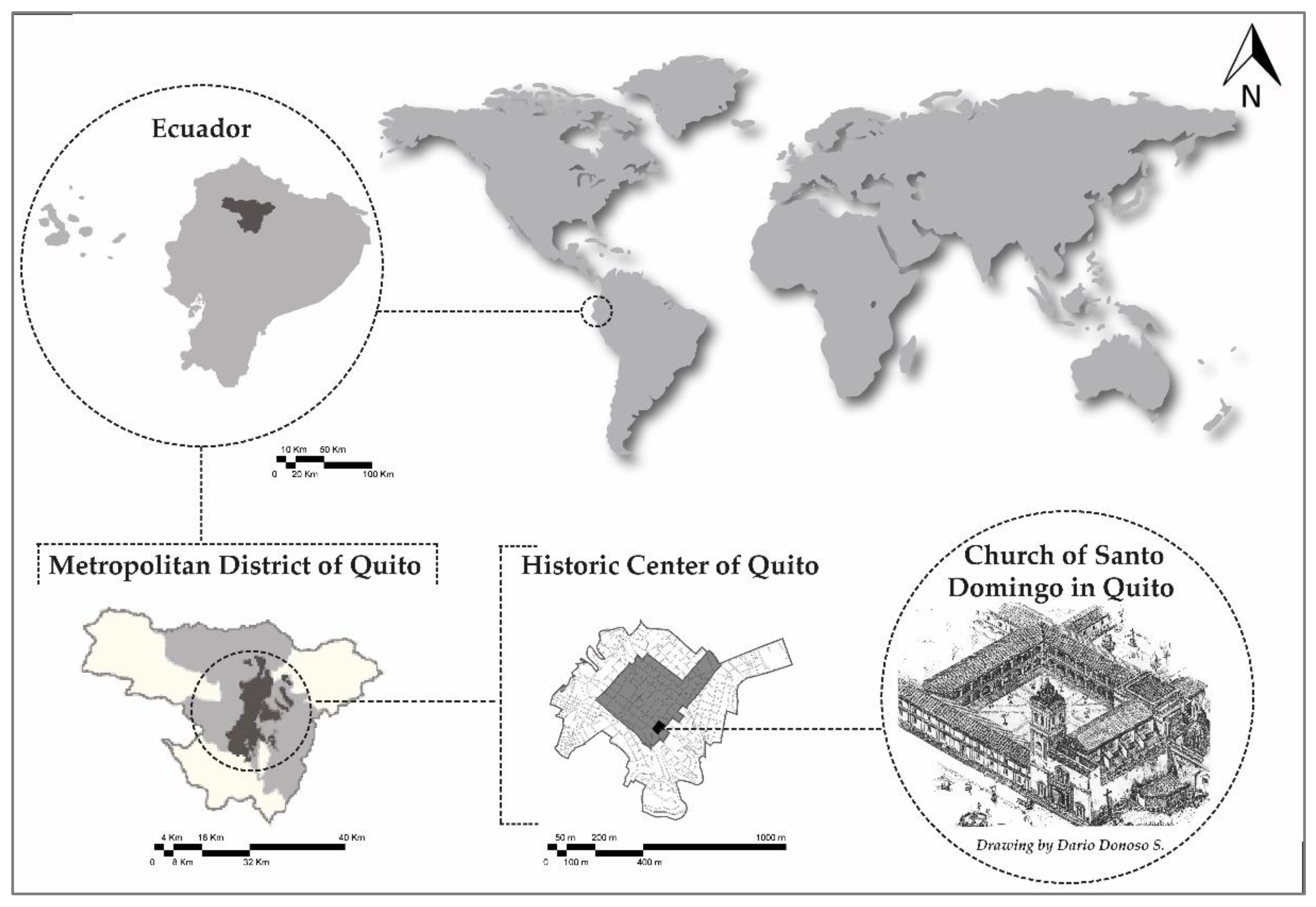
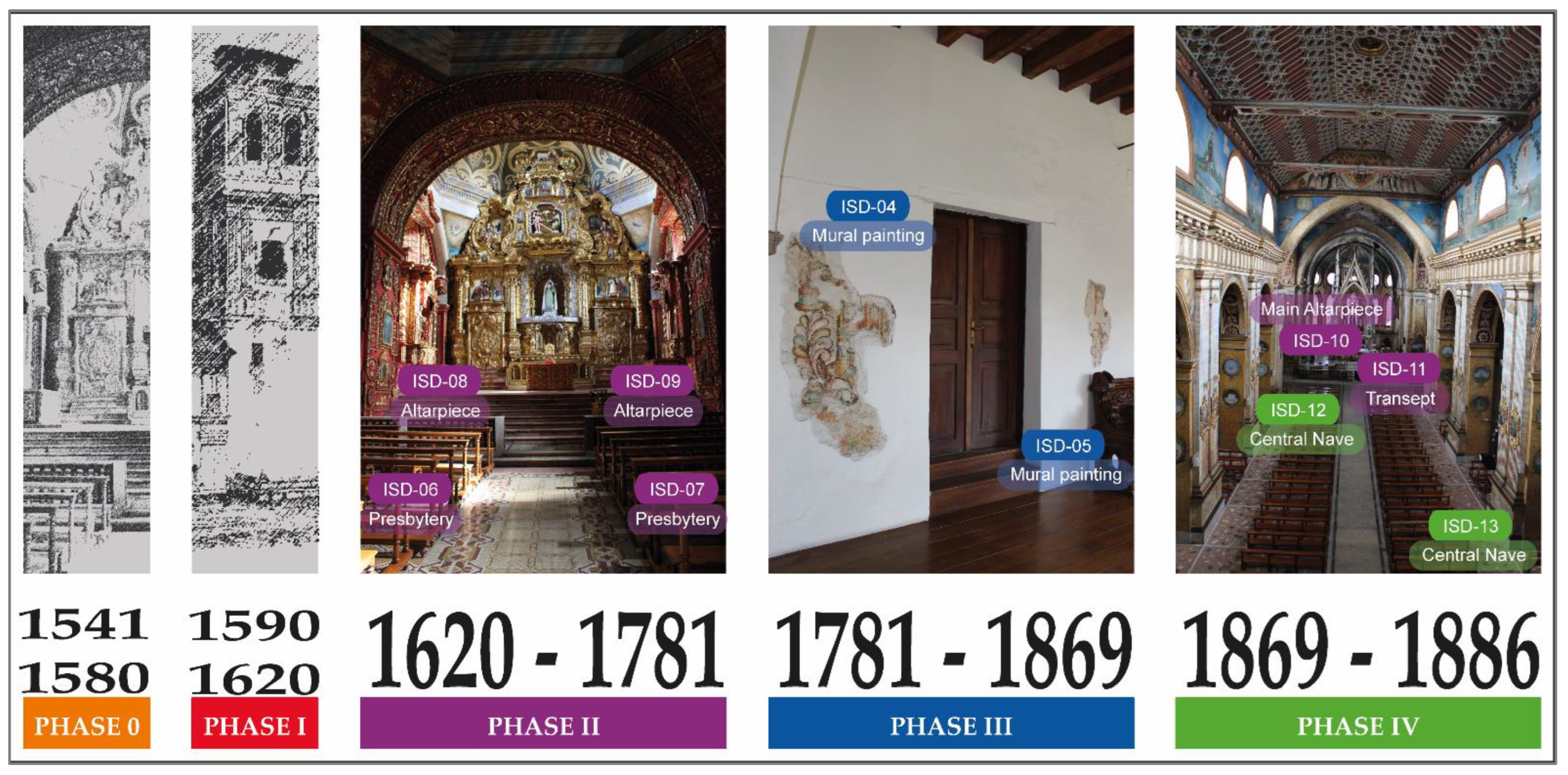
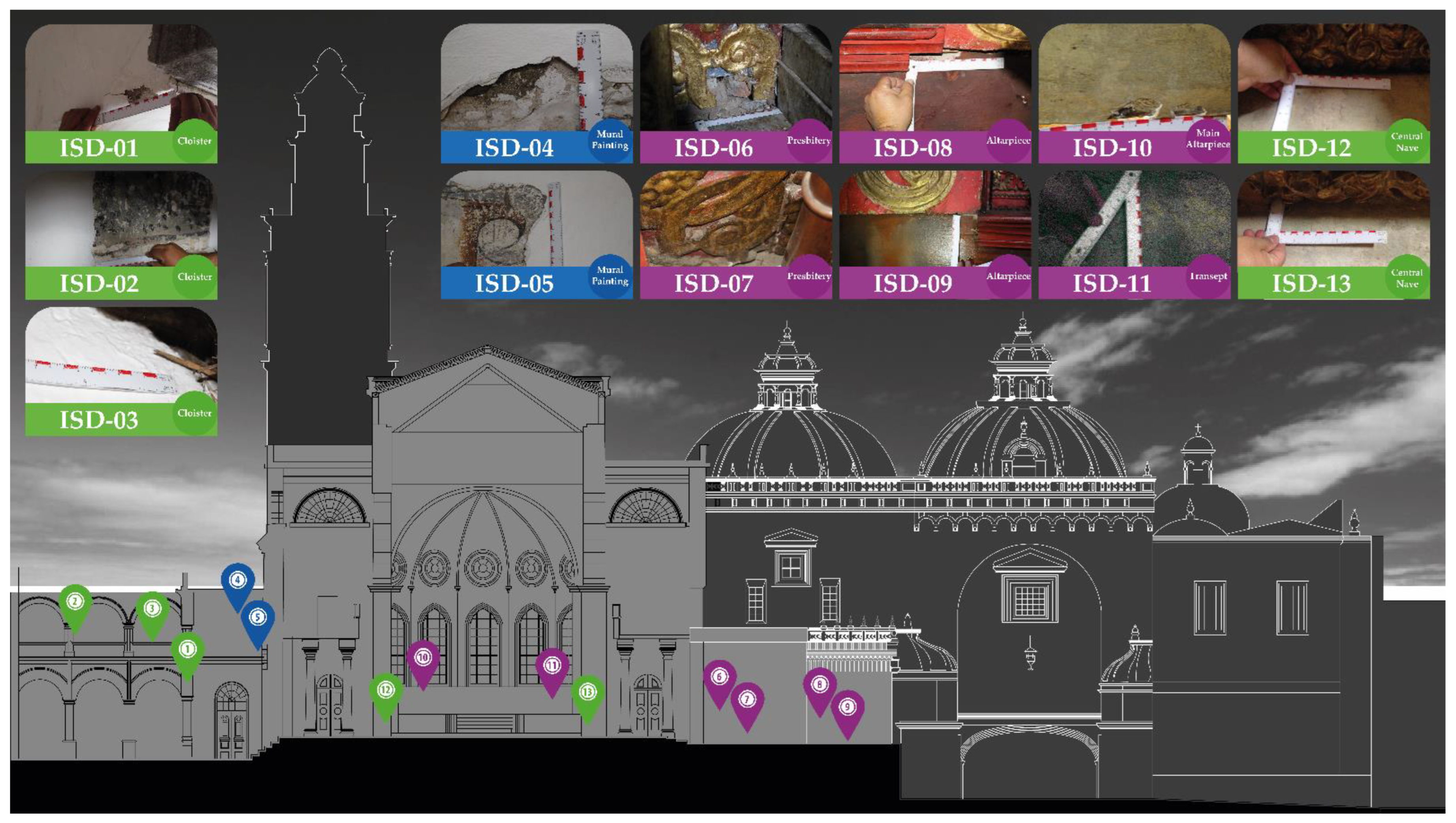
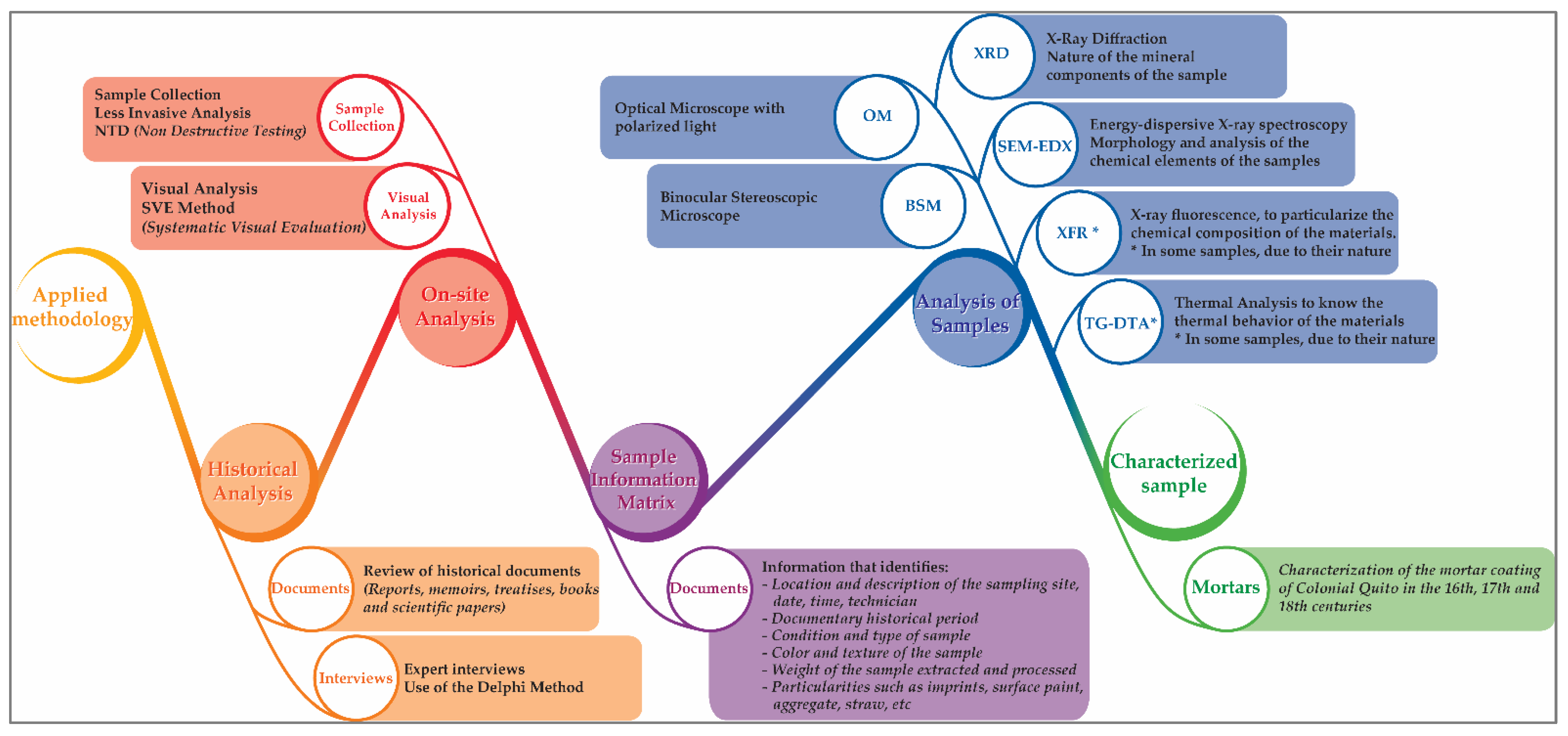
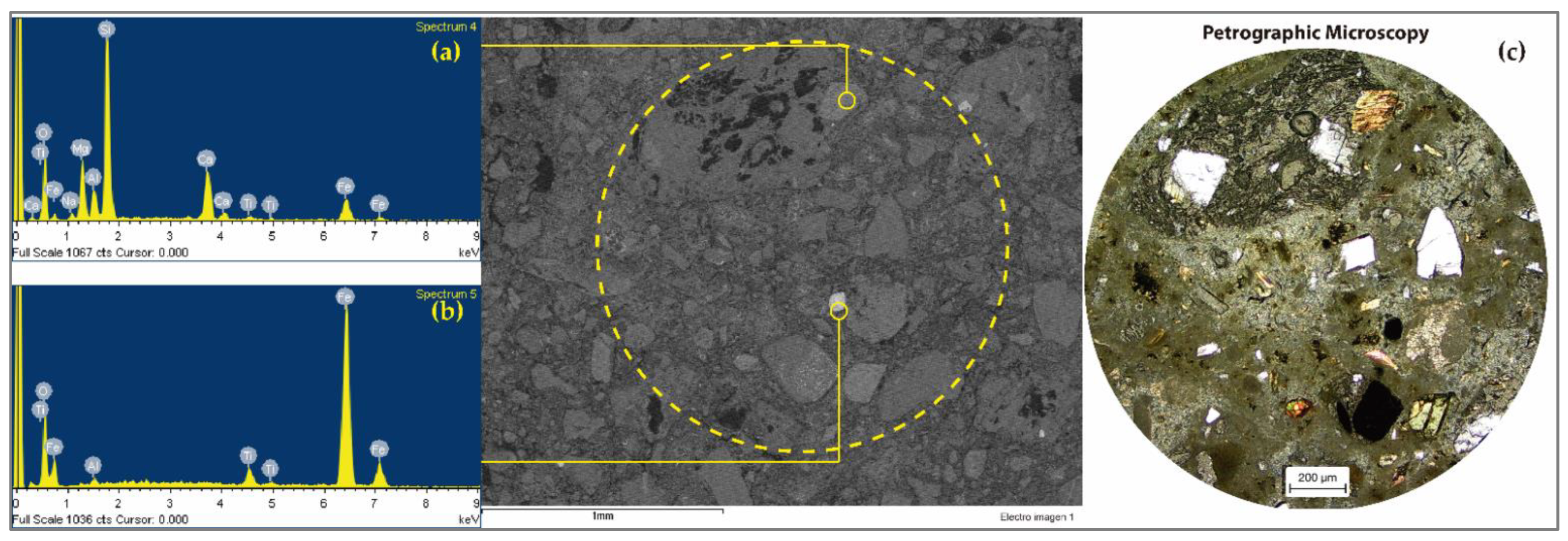
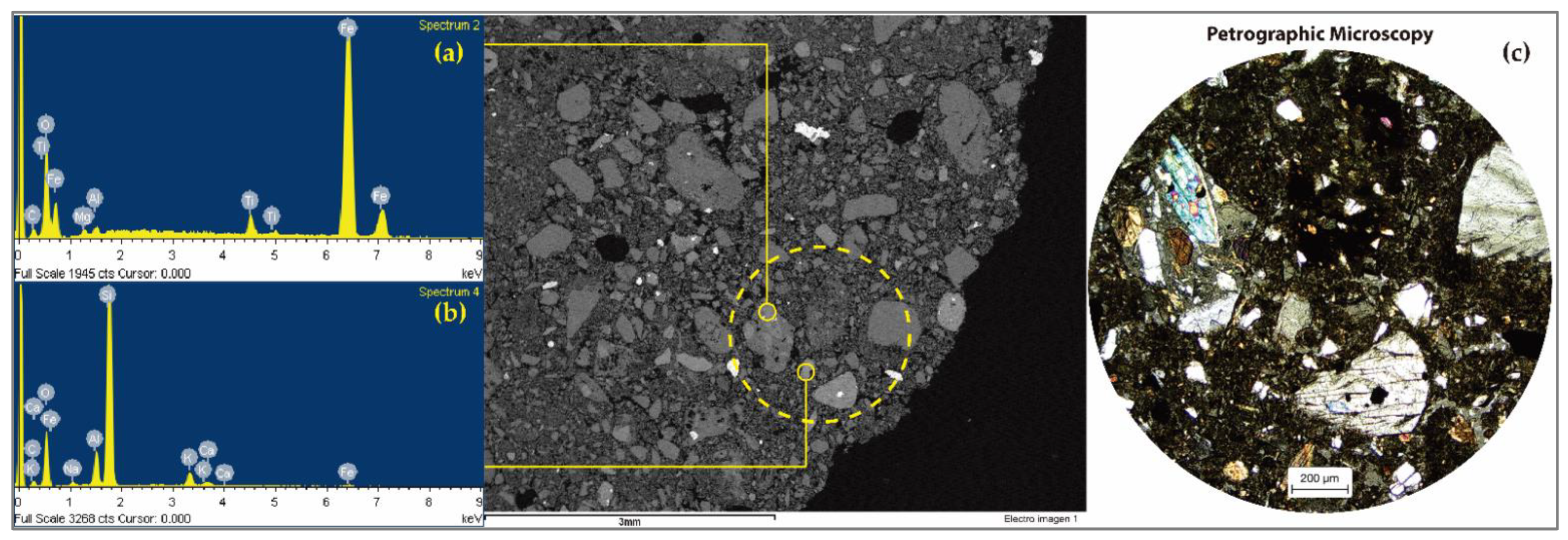
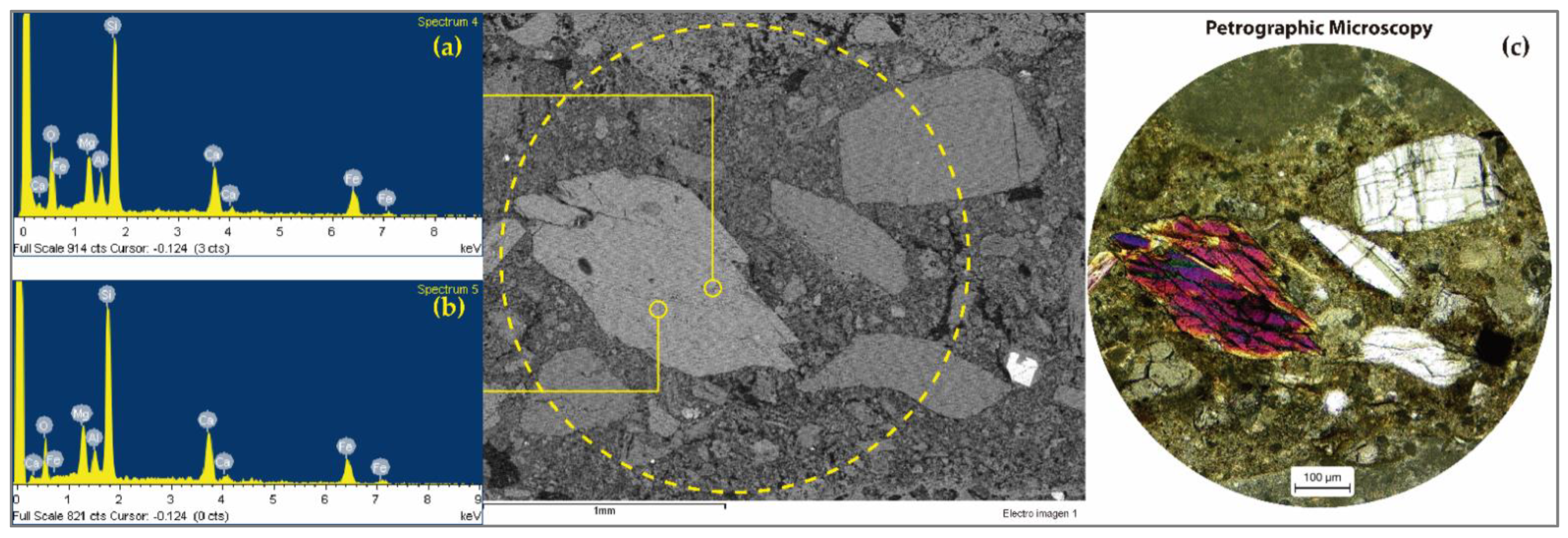
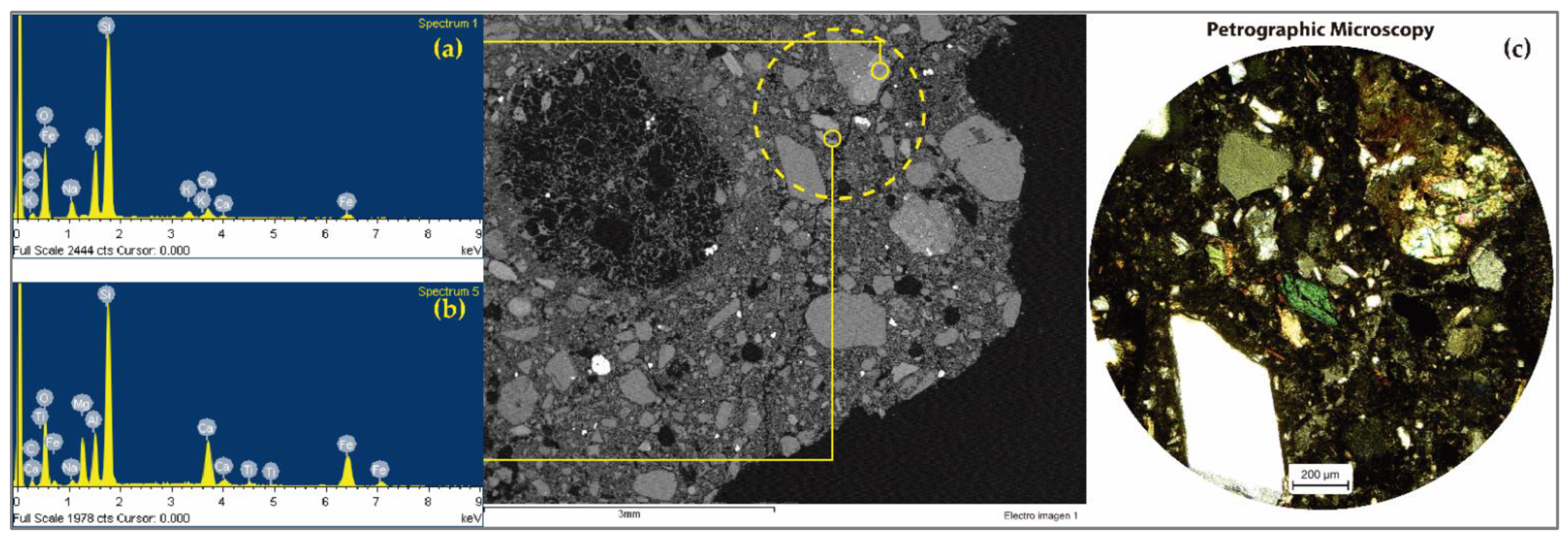
| Samples | ||||||
|---|---|---|---|---|---|---|
| Qz | Pl | Amp | Cal | Ilt | Lrn | |
| ISD-06 | 3 | 87 | 6 | 4 | ||
| ISD-07 | <1 | 86 | 12 | 2 | ||
| ISD-08 | 57 | 22 | 18 | 3 | ||
| ISD-09 | 1 | 70 | 18 | 10 | 1 | |
| ISD-10 | <1 | 88 | 6 | 5 | 1 | |
| ISD-11 | 3 | 84 | 9 | 4 | ||
| ISD-04 | 2 | 64 | 12 | 6 | 4 | 11 |
| ISD-05 | 2 | 80 | 7 | 8 | 3 | |
| ISD-01 | 2 | 74 | 18 | 4 | 2 | |
| ISD-02 | 92 | 2 | 3 | 3 | ||
| ISD-03 | 3 | 54 | 7 | 30 | 6 | |
| ISD-12 | 2 | 80 | 13 | 5 | ||
| ISD-13 | 2 | 83 | 9 | 6 | ||
| Samples | Mortar |
|---|---|
| ISD-06 | Volcanic aggregate |
| ISD-07 | Volcanic aggregate |
| ISD-08 | Lime mortar with volcanic aggregates |
| ISD-09 | Lime mortar with volcanic aggregates |
| ISD-10 | Lime mortar with volcanic aggregates |
| ISD-11 | Volcanic aggregate |
| ISD-04 | Intervened area “cement mortar” |
| ISD-05 | Lime mortar with volcanic aggregates |
| ISD-01 | Lime mortar with volcanic aggregates |
| ISD-02 | Lime mortar with volcanic aggregates |
| ISD-03 | Lime mortar with volcanic aggregates |
| ISD-12 | Volcanic aggregate |
| ISD-13 | Volcanic aggregate |
Publisher’s Note: MDPI stays neutral with regard to jurisdictional claims in published maps and institutional affiliations. |
© 2022 by the authors. Licensee MDPI, Basel, Switzerland. This article is an open access article distributed under the terms and conditions of the Creative Commons Attribution (CC BY) license (https://creativecommons.org/licenses/by/4.0/).
Share and Cite
Lara Calderón, M.L.; Sanz-Arauz, D.; López-Andrés, S.; Pino, I.d. Characterization and Analysis of the Mortars of the Church of Santo Domingo in Quito (Ecuador). Heritage 2022, 5, 4024-4036. https://doi.org/10.3390/heritage5040207
Lara Calderón ML, Sanz-Arauz D, López-Andrés S, Pino Id. Characterization and Analysis of the Mortars of the Church of Santo Domingo in Quito (Ecuador). Heritage. 2022; 5(4):4024-4036. https://doi.org/10.3390/heritage5040207
Chicago/Turabian StyleLara Calderón, M. Lenin, David Sanz-Arauz, Sol López-Andrés, and Inés del Pino. 2022. "Characterization and Analysis of the Mortars of the Church of Santo Domingo in Quito (Ecuador)" Heritage 5, no. 4: 4024-4036. https://doi.org/10.3390/heritage5040207
APA StyleLara Calderón, M. L., Sanz-Arauz, D., López-Andrés, S., & Pino, I. d. (2022). Characterization and Analysis of the Mortars of the Church of Santo Domingo in Quito (Ecuador). Heritage, 5(4), 4024-4036. https://doi.org/10.3390/heritage5040207








